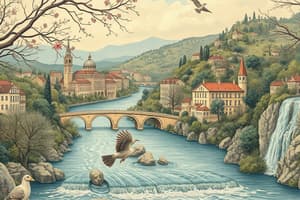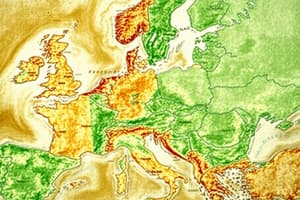Podcast
Questions and Answers
What type of birds are known to inhabit the Elbe Sandstone Mountains in Europe?
What type of birds are known to inhabit the Elbe Sandstone Mountains in Europe?
- Peregrine falcons and grey wagtails (correct)
- Cormorants and pelicans
- Alpine chuffs and golden eagles
- Ospreys and seagulls
How were the rock formations in the Elbe Sandstone Mountains believed to have originated?
How were the rock formations in the Elbe Sandstone Mountains believed to have originated?
- From glacial movements
- In a primeval sea during the Tethys Ocean era (correct)
- Due to volcanic activity
- Through underground magma chambers
What event led to the formation of the Alps, the largest mountains in Central Europe?
What event led to the formation of the Alps, the largest mountains in Central Europe?
- Impact of a meteorite
- Collision of Africa with Europe (correct)
- Tectonic subduction
- Erosion caused by wind
Which animals are mentioned as being adapted to the high altitudes of the Western Alps?
Which animals are mentioned as being adapted to the high altitudes of the Western Alps?
What is a notable feature of the Danube Delta that makes it unique?
What is a notable feature of the Danube Delta that makes it unique?
Which event led to the formation of Europe's only desert in Tabernas, Spain?
Which event led to the formation of Europe's only desert in Tabernas, Spain?
What was the significance of Pliny the Younger's observations of Vesuvius eruption?
What was the significance of Pliny the Younger's observations of Vesuvius eruption?
What is the main role of Danube Delta in the context of migratory birds?
What is the main role of Danube Delta in the context of migratory birds?
What is Vienna known for in relation to prehistoric animals?
What is Vienna known for in relation to prehistoric animals?
Why is it emotionally significant for a geologist to stand where Pliny the Younger once stood?
Why is it emotionally significant for a geologist to stand where Pliny the Younger once stood?
Flashcards are hidden until you start studying
Study Notes
- Colin Devey is on an expedition exploring the natural wonders of the European continent, from the Mediterranean to Iceland.
- The Elbe Sandstone Mountains in Europe are unique with steep rocks, ideal for birds like peregrine falcons and grey wagtails.
- The rock formations in the Elbe Sandstone Mountains originated in a primeval sea 100 million years ago during the Tethys Ocean era.
- The Alps, the largest mountains in Central Europe, were formed due to the collision of Africa with Europe, creating a spectacular mountain range.
- Alpine chuffs, golden eagles, and alpine ibexes are some of the animals adapted to the high altitudes of the Western Alps.
- The mountains, like the Matterhorn, are constantly changing due to rock expansion and contraction, leading to rock slides and landscape transformations.
- Geologists study the Alps to understand the history of the landscape, tracing back to the collision of continental plates from Africa and Europe.- 50 million years ago, the African plate collided with Europe, giving rise to the Alps and creating new areas in Africa.
- The Danube Delta is a species-rich natural site in Europe, home to over 5,000 animal and plant species, including 300 bird species.
- The Danube Delta is the largest contiguous area of reedbeds on the planet, offering nesting sites and abundant food for birds like cormorants and pelicans.
- The Danube Delta serves as a crucial meeting point for migratory birds traveling between Europe, Africa, and Asia to raise their young.
- Golden jackals have recently migrated into the Danube Delta from the south, showcasing the importance of animal migrations for evolution.
- Vienna, with its mild climate, was once home to prehistoric animals like the Aceratherium and Chalicotherium during the Miocene period.
- Tabernas in Spain is Europe's only desert, featuring unique plant species adapted to arid conditions and evidence of its ancient oceanic past.
- The Mediterranean Sea dried out six million years ago due to geological changes at Gibraltar, forming a vast salty desert landscape in the Tabernas region.
- The Ice Age, starting about 2.7 million years ago, transformed landscapes across Europe, leading to the retreat of glaciers and the emergence of unique habitats.
- Mount Vesuvius near Naples, Italy, erupted cataclysmically in 79 A.D., burying the town of Pompeii and its inhabitants in ash and providing fertile soil for new life to emerge.- Forces of the planet can be dangerous yet essential for life, emphasizing the importance of studying and understanding them.
- Pliny the Younger's observations of Vesuvius eruption 1,900 years ago, which destroyed Pompeii, laid the foundation for the study of geology.
- Being a geologist, standing in the same location where Pliny the Younger once stood is emotional and significant.
- The constant motion of the planet highlights the importance of observing and studying it continuously.
- The speaker reflects on the value of taking a closer look at Earth's dynamics and concludes with a cheerful goodbye.
Studying That Suits You
Use AI to generate personalized quizzes and flashcards to suit your learning preferences.




